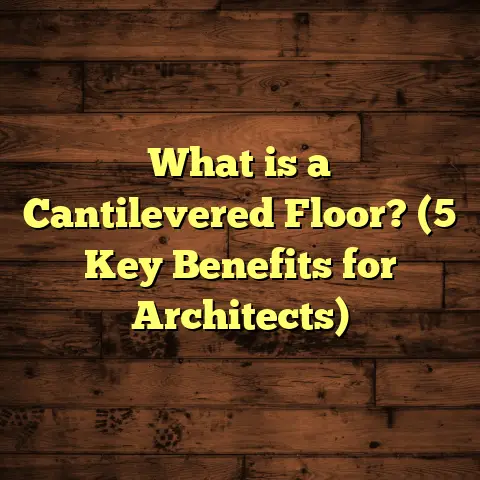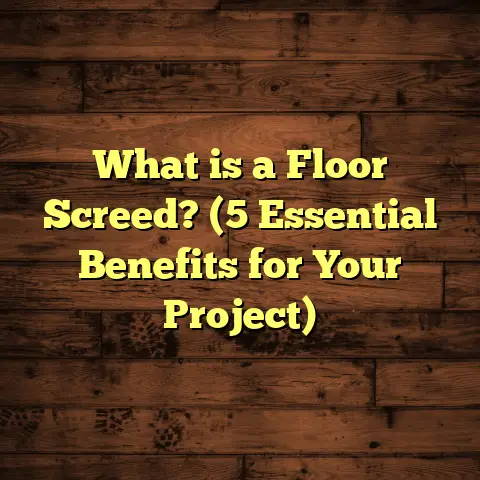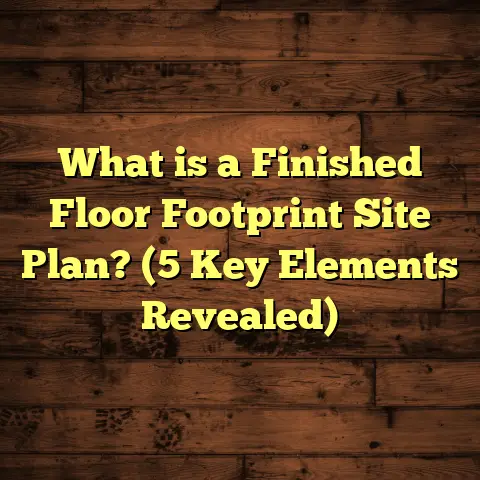What is Flooring? (5 Key Benefits for Your Home Decor)
Flooring shapes the soul of a home. It’s far more than just a surface beneath your feet—it’s the foundation of style, comfort, and durability that carries you through daily life. When I first started working in flooring, I quickly realized there’s much more to it than just picking a material. Flooring directly affects how a room looks and feels, how long it lasts, and even how much value your home holds. Over the years, I’ve seen how something as simple as the right floor can transform a space and make life easier.
What Is Flooring?
Let’s start with the basics—what exactly is flooring? Flooring is any permanent material or finish applied over a floor’s structural base. This base might be concrete, plywood, or another subfloor that supports the flooring layer. It’s the surface you walk on every day but also acts as protection for the structure beneath from damage, moisture, and wear.
There are many types of flooring materials, each with unique characteristics:
- Hardwood: Solid wood planks from species like oak, maple, or walnut.
- Engineered Wood: Layers of wood veneer over plywood or composite for stability.
- Laminate: Multi-layer synthetic product designed to mimic wood or stone.
- Vinyl: Flexible sheets or planks that can resemble wood or tile.
- Tile: Ceramic or porcelain tiles favored for kitchens and baths.
- Carpet: Soft fabric fibers woven or tufted for warmth and noise reduction.
- Natural Stone: Materials like marble, slate, or granite for luxury finish.
- Cork and Bamboo: Eco-friendly options with unique textures.
Each one serves different needs depending on style preferences, budget, durability requirements, climate, and room function.
Why Does Flooring Matter So Much?
Think about your favorite rooms—what’s on the floor? It sets the tone for the entire space. A sleek tile floor can make a kitchen look clean and modern; warm hardwood adds coziness to a living room. Beyond looks, flooring influences comfort, safety, maintenance effort, and even your home’s resale value.
When I first installed hardwood floors in my own home nearly two decades ago, I didn’t realize how much impact they’d have on daily life. The warmth they added, the ease of cleaning compared to carpet, even how guests commented on them made me appreciate flooring as an essential design element—not just an afterthought.
Benefit 1: Flooring Boosts Home Aesthetic
Have you ever walked into a room and instantly felt either relaxed or energized? Flooring plays a huge role in that first impression.
I remember helping my parents remodel their living room about three years ago. Their old carpet was faded and stained—nothing matched. We chose a medium-tone oak hardwood floor with a matte finish. The natural grain patterns added warmth and texture that paint or wallpaper alone couldn’t provide. The room felt cozy but still bright. The transformation happened fast—just a weekend of installation—and made the space inviting instantly.
Why does flooring impact aesthetics so much? Partly because it covers a large area visible from every angle. The color, pattern, and texture influence room size perception and mood:
- Light colors like white oak or bleached maple can make small rooms feel bigger and airier.
- Dark floors add sophistication and depth but can make spaces feel smaller.
- Patterns such as herringbone or chevron add visual interest without cluttering.
- Texture matters too—a hand-scraped hardwood has character versus smooth polished planks.
A study by the National Wood Flooring Association (NWFA) found 75% of homeowners rank hardwood floors as the top upgrade to improve home appearance and resale value. That wasn’t surprising to me given how many clients choose wood for its timeless look.
If you want style without breaking the bank, laminate floors come in hundreds of designs mimicking wood or stone at around $2–$5 per square foot installed—compared to $8–$15 for real hardwood.
Even vinyl plank flooring has gotten so realistic you’d have to get close to tell it’s not wood. For kitchens or bathrooms where moisture is concern, these are great affordable options with lots of aesthetic flexibility.
Personal Story: How Flooring Defined Our Family Room
When my wife and I moved into our first house together, the family room had ugly old linoleum that clashed with our furniture. We decided on a warm cherry hardwood with wide planks (5 inches wide) to give a modern yet cozy vibe. Installation took about three days for 900 square feet with a professional crew.
We made sure to select a matte finish so scratches wouldn’t show easily with kids running around.
The difference was night and day: the floor drew compliments instantly from visitors. Plus, it set the tone for other décor choices—throw rugs, furniture colors—all based around that rich red-brown floor.
Benefit 2: Longevity and Durability Save Money
One thing I’ve learned over thousands of installations is that flooring is an investment in your home’s future. Cheaper options may seem attractive at first but often need replacing much sooner. That adds up—both in cost and hassle.
Take carpet for example; many low-end carpets last 5-7 years before looking worn or stained beyond repair. I’ve seen families replace carpet multiple times in high-traffic areas like hallways or living rooms.
Hardwood floors can last 30-100 years if properly cared for. I installed red oak floors in an Ohio family home 15 years ago; last year they refinished them instead of replacing. The cost? About $2 per square foot to sand and apply new finish compared to $8+ per square foot for new hardwood installation.
Vinyl plank flooring with waterproof cores is another durable choice gaining popularity in regions with humidity like Florida. It resists warping unlike solid wood and costs $3–$7 per square foot installed.
Durability depends on traffic levels too:
- Hallways or entryways require tougher surfaces like ceramic tile or high-grade engineered hardwood.
- Bedrooms often tolerate softer options like carpet or cork well since foot traffic is lighter.
If you want numbers: A well-maintained hardwood floor averages around $5 per year over its lifespan for maintenance—buffing and refinishing—compared to replacing carpet every decade at $2–$3 per square foot each time.
Real-Life Case Study: Flooring That Lasts Decades
One client in Minnesota had 100-year-old pine floors in their historic home. They invested $15 per square foot restoring original wood rather than ripping it out for new carpet.
The restored floors added character and authenticity that raised their home’s market value by 12%, according to their realtor.
Benefit 3: Easy Maintenance Makes Life Simpler
Let’s be honest: who loves scrubbing floors endlessly? No one I know!
One of the biggest perks I’ve found over years of installing floors is how some types make cleaning almost effortless. Vinyl and laminate floors are extremely low-maintenance—just sweeping regularly and occasional damp mopping keep them looking fresh.
Hardwoods require a bit more care: avoid soaking water which damages wood fibers; use cleaners designed for wood surfaces to maintain finish quality. But once you establish a routine it’s manageable.
Carpets trap dust mites and allergens requiring frequent vacuuming plus professional deep cleaning annually or bi-annually. That can get expensive depending on carpet type and local cleaning rates ($100–$300 per session).
Here’s a personal tip: After my son was born, we installed luxury vinyl planks in our kitchen because spills wiped up instantly without staining or warping—huge relief compared to our old carpeted dining area.
Maintenance Comparison Chart (Average Annual Effort & Cost)
| Flooring Type | Maintenance Tasks | Average Annual Cost | Notes |
|---|---|---|---|
| Hardwood | Sweeping, damp mop, refinishing every 10 years | $5–$10 per sq.ft over 10 years | Needs careful cleaner choice |
| Vinyl/Laminate | Sweeping, occasional mop | <$1 per sq.ft | Waterproof types very low effort |
| Carpet | Vacuuming weekly + deep cleaning | $100–$300 | Allergens & stains require care |
| Tile | Sweeping + grout cleaning | $1–$2 per sq.ft | Grout maintenance needed |
Benefit 4: Improves Home Value Significantly
Are you thinking about selling your house someday? Flooring can be one of the smartest investments to increase resale value.
Zillow reports homes with hardwood floors sell for an average of 1–2% more than comparable homes without them. Let’s say your property is worth $300,000—that’s an extra $3,000–$6,000 just by upgrading floors!
In my experience across California and Texas projects, clients typically recoup 70–80% of flooring costs at sale if they pick materials popular locally (bamboo in eco-friendly markets; tile in hot climates).
Timing also matters; upgrading worn carpet with fresh hardwood or tile before listing can speed up sales by several weeks because buyers notice condition immediately.
Data Point: Flooring Impact on Resale Across US Markets
According to Remodeling Magazine’s Cost vs. Value Report (2023):
| Flooring Upgrade | Average Cost (USD) | Resale Value Increase (%) |
|---|---|---|
| Hardwood Flooring | $8,500 | 70–80% |
| Vinyl Plank Flooring | $4,200 | 60–70% |
| Tile Installation | $9,000 | 65–75% |
| Carpet Replacement | $2,500 | 30–40% |
Benefit 5: Enhances Comfort and Safety
Floors affect more than looks—they influence comfort underfoot daily. Ever notice how cold tile feels harsh barefoot in winter? Or how plush carpet softens footsteps?
I installed cork flooring once in a nursery because cork naturally absorbs sound and offers gentle cushioning—perfect for babies learning to walk without harsh falls.
Safety matters as well. Non-slip flooring reduces accidents especially for kids or elderly family members. Rubber tiles in home gyms or textured vinyl in bathrooms help prevent slips.
Thermal comfort is another factor. Radiant floor heating under tile or stone keeps feet warm without bulky rugs—ideal for colder climates or anyone who loves cozy mornings at home.
Deeper into Material Choices: Pros and Cons Based on Experience
Choosing flooring isn’t just about looks—it impacts your daily routine and long-term satisfaction.
Here’s what I’ve learned hands-on installing floors across various homes:
Hardwood Floors
Pros: Classic beauty, excellent durability if maintained properly; adds value; can be refinished multiple times
Cons: Higher upfront cost ($8-$15/sq.ft installed); sensitive to moisture; requires regular maintenance
Installation: Typically nailed down over plywood subfloor; takes 2–4 days for average 1,000 sq.ft room
Maintenance: Sweep regularly; refinish every 7–10 years; avoid water pooling
Laminate Floors
Pros: Affordable ($2–$5/sq.ft); easy DIY installation; many design options mimicking wood/stone
Cons: Less durable than hardwood; sensitive to water damage; cannot be refinished
Installation: Click-lock floating system; often done in 1–2 days
Maintenance: Simple sweeping/mopping; avoid excess water
Vinyl Plank Floors
Pros: Waterproof options available; low maintenance; good durability; budget-friendly ($3–$7/sq.ft)
Cons: Can dent under heavy furniture; less eco-friendly
Installation: Glue down or click-lock; quick installation; suitable for bathrooms/kitchens
Maintenance: Sweep/mop regularly; no special cleaners needed
Ceramic/Porcelain Tile
Pros: Durable; water-resistant; great for wet areas; wide style range
Cons: Hard/cold surface; grout requires maintenance; installation costly ($10-$20/sq.ft)
Installation: Mortar + grout; professional needed; takes several days depending on size
Maintenance: Clean grout periodically; avoid harsh chemicals
Carpet
Pros: Warm underfoot; noise absorption; affordable initial cost ($1-$3/sq.ft)
Cons: Stains easily; traps allergens; needs frequent cleaning/replacement
Installation: Padding + stretch-in method; DIY difficult but possible
Maintenance: Vacuum regularly; professional cleaning at least yearly
Regional Considerations Affecting Flooring Choices
Where you live changes which floors make most sense:
- Humid climates (Florida, Louisiana): Waterproof vinyl or tile preferred to prevent mold/mildew issues.
- Cold climates (Minnesota, Maine): Hardwood with radiant heating or carpet for warmth.
- Eco-conscious areas (Portland, Seattle): Bamboo or cork growing in popularity due to sustainability.
- Urban apartments: Laminate or engineered wood common due to ease of installation/removal.
In my work traveling between Midwest and West Coast homes, adapting material recommendations based on local climate has been key to client satisfaction.
Installation Timelines & Costs from My Experience
Here’s a breakdown from recent projects to give perspective:
| Flooring Type | Avg Cost Installed (per sq.ft) | Installation Time (for ~1000 sq.ft) | Notes |
|---|---|---|---|
| Hardwood | $8 – $15 | 2 – 4 days | Includes sanding & finishing |
| Laminate | $2 – $5 | 1 – 2 days | DIY-friendly |
| Vinyl Plank | $3 – $7 | 1 – 3 days | Waterproof options available |
| Tile | $10 – $20 | 3 – 5 days | Grout curing time crucial |
| Carpet | $1 – $3 | Less than 1 day | Quick install but needs padding |
Material costs fluctuate based on quality and regional labor expenses. For example, hardwood installation in New York City may run higher due to labor rates versus rural Midwest areas by up to 30%.
Waste Factor & Planning Tips
Never order exactly your room size in materials! Expect about 5–10% extra for cuts and mistakes:
- Complex patterns like herringbone require up to 15% waste.
- Tile requires spare pieces for future repairs.
- Laminate’s click-lock installation demands careful layout planning.
I always advise clients to buy slightly more than needed upfront—it saves headache mid-project.
Personal Anecdote: When Flooring Decisions Got Tricky
One client wanted whitewashed hardwood for their beach house near Miami—a gorgeous idea but tricky due to humidity risks. We opted instead for waterproof vinyl plank with a similar look after extensive research showed better longevity without warping issues.
They loved the final result—stylish yet practical—and avoided costly repairs down the line.
Final Thoughts on Flooring Benefits
To wrap up (without wrapping up!), flooring does more than fill space:
- It defines your home’s personality visually.
- It protects your investment by lasting decades.
- It simplifies your cleaning routine.
- It boosts resale value significantly.
- It makes your daily life safer and more comfortable.
I hope sharing my experiences along with data helps you see how important thoughtful flooring choices are—and maybe sparks ideas for your own project!
If you want tailored advice on materials fitting your lifestyle, budget estimates including labor/materials based on your zip code (I use FloorTally often), or troubleshooting common issues like squeaky floors or moisture damage—I’m here to help!
What questions do you have about your next flooring upgrade?





